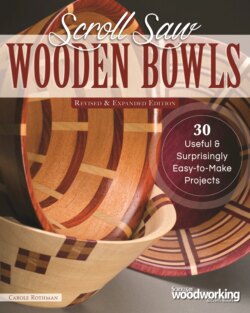Читать книгу Scroll Saw Wooden Bowls, Revised & Expanded Edition - Carole Rothman - Страница 28
Demystifying the cutting angle
ОглавлениеComputing the cutting angle isn’t magic, just trigonometry. For every combination of wood thickness and ring width, there is a cutting angle that will produce a perfect alignment when concentric rings are stacked. This angle is usually referred to as “the” cutting angle, and bowls made from rings cut at this angle have straight sides. To make curved-sided bowls, the first ring is cut at “the” cutting angle, but then the cutting angle is increased with each successive ring.
Instructions for all projects in this book provide the required cutting angles. However, these angles will only work as expected if your blank is the thickness specified in the materials list. If you want to use wood that is thicker or thinner, you will need to compute a new cutting angle. For straight-sided bowls, the angle you compute is the one you’ll use for all the rings of the bowl. For curved-sided bowls, the angle you compute will be used for the first ring only, then increased with each successive ring. Computing the angle is not difficult, and on see here you’ll find the information you need to do this. You can also go to scrollmania.com, where you’ll find an app that does the computation for you once you’ve provided the wood thickness and ring width. This easy-to-use site, designed for makers of scrolled bowls, also contains powerful tools for creating your own bowl patterns.
A bowl with rings cut at a constant angle has sides that form a straight line.
Curved sides are created by increasing the cutting angle from ring to ring.
The chart on see here gives the cutting angles for three typical ring widths, using stock that is ½” (13mm) or ¾” (19mm) thick. Cutting your rings at these angles will result in a near-perfect alignment when used to make a straight-sided bowl from a single piece of wood. If you do the computations yourself, you’ll find that I’ve added in a small margin for error for all but the 45˚ cut. For example, the computed cutting angle for the combination of 3/8” (10mm) ring width and ¾” (19mm) blank thickness is 26.6˚, not 28˚.
Patterns and project size
Every pattern in this book specifies its exact size when copied at the designated percentage. After making your copy, be certain it is sized correctly.
To change the size of a project by reducing or enlarging the pattern, you must either redraw the rings to their original width or change the cutting angle. To do so, use the formula on see here or the Angle Calculator that can be found at scrollmania.com.
I’ve made adjustments like these throughout the book to compensate for minor cutting deviations and imprecise angle settings on the scroll saw. These angles are sufficiently precise for a good alignment, and provide a little extra wood to compensate for miscuts. However, if you use a digital angle guide to set your saw and are confident in the precision of your cuts, you can decrease that margin and use 27˚, for example, rather than 28˚, for a slightly better alignment. Information on using multiple angles to produce curved sides is introduced in Chapter Four.
Cutting angles for straight-sided bowls
| Wood thickness | Ring cutting | Cutting angle |
| ½" (13mm) stock | ½" (13mm) | 45˚ |
| ½" (13mm) stock | 3/8" (10mm) | 38˚ |
| ½" (13mm) stock | ¼" (6mm) | 28˚ |
| ¾" (19mm) stock | ½" (13mm) | 34˚ |
| ¾" (19mm) stock | 3/8" (10mm) | 28˚ |
| ¾" (19mm) stock | ¼" (6mm) | 20˚ |
